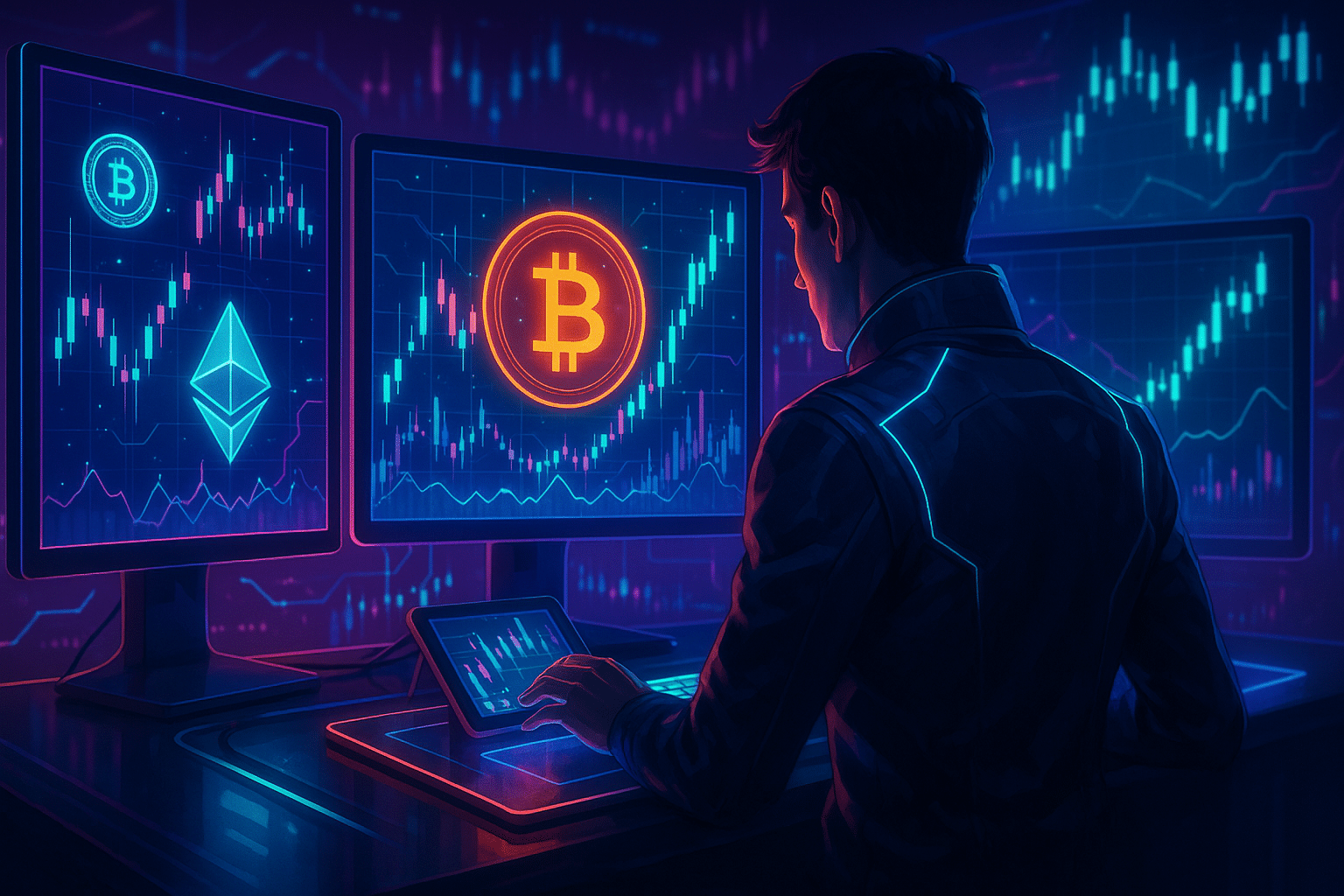Crypto Technical Analysis Tools for Beginners: Easy Guide to Crypto Charts and Indicators
Crypto trading looks fast and confusing for many new traders. Prices go up fast, and then they fall, and sometimes it feels like guessing. But many traders around the world use charts and special tools to study market movement. This simple guide explains technical analysis in basic English. It shows the tools, the charts, and the indicators beginners use when learning how to read crypto price moves.
Technical analysis sounds complicated, but it only means checking charts to understand price behavior. It is not magic. It is not perfect. It is just a method to learn the trend and make a more informed decision. This guide keeps everything simple. Mistakes in sentence structure are normal here, so reading feels like a real person talking. Also, no special symbols or fancy grammar.
What Is Crypto Technical Analysis in Simple Words
Technical analysis means studying price charts and indicators to understand where crypto markets may go. Traders use it to guess if the price will go up or down. They do not predict the future perfectly. They only improve their chances. Charts show the story of buyers and sellers. Many crypto traders do not want to depend only on news. They look at price behavior also.
In crypto, the price sometimes reacts fast to news, hype, fear, and rumors. Basic charts help understand when the market looks strong and when it looks weak. Trading without looking at charts is like walking in a room with no lights. So, technical analysis is like switching lights on.
Why Crypto Technical Analysis Matters
Crypto markets move 24 hours, and they never rest. Stocks sleep, but crypto keeps moving. This means trends change fast. Beginners sometimes feel lost and panic buy or panic sell. Charts help reduce fear and emotional decisions. When the trend is clear, traders feel calmer. It also gives simple rules like buy when the price is strong or avoid when the price looks weak.
Technical analysis also helps avoid trusting random internet tips. Social media talks a lot, and many guesses are wrong. Charts help traders become more independent and steady.
Key Crypto Technical Analysis Tools for Beginners
Many tools exist, but beginners should not try everything at once. Start with simple ones that show price clearly. Below are tools that most beginners use.
TradingView
TradingView is the most popular chart website. It lets users study Bitcoin, Ethereum, and all major coins. It has free charts, easy trend lines, and many indicators. New traders can practice reading candles and drawing lines. It also has demo so no real money is needed to learn.
CoinMarketCap and CoinGecko
These two websites show crypto prices, trading volume, market cap, and charts, too. They are good for quick checks. They do not have deeper chart tools like TradingView, but good for beginners to see price trends and market moods.
Exchange Chart Screens
Most exchanges like Binance or Coinbase have built-in charts. They are simple but enough for starting. Many beginners first see Japanese candles here. They also have small tools like moving average lines and volume bars.
Crypto Fear and Greed Index
Crypto Fear and Greed Index shows how people feel. If fear is high, traders panic. If greed is high, traders chase pumps. This helps understand emotion in the market, which is a big part of crypto price movement.
Basic Chart Types Beginners Should Learn
Charts show price movement in different ways. Some charts look simple and some show more detail.
Line Chart
A line chart is basic. It shows a single line connecting closing prices. It is simple to read and good for learning first. It shows a general trend but not much detail about the price within the time period.
Candlestick Chart
A candlestick chart shows the open, close, high, and low of every period. It has green candles and red candles. Green means price went up. Red means the price went down. Candles show more information, like whether the price moved fast or slow. Most crypto traders use this chart.
Bar Chart
Bar chart also shows open, close, high, low but in a different style. Many beginners skip this because candles are easier to see.
Must Learn Crypto Indicators for Beginners
Indicators are tools on charts that help traders see signals. Indicators are not always right. They only support decisions. Beginners should learn slow and not add too many indicators at once.
Moving Averages SMA and EMA
Moving average shows the average price across time. SMA is a simple moving average. EMA is an exponential moving average, which reacts faster. If the price stays above the moving average line, the trend is often considered strong. If the price falls below the line, the trend can turn weak.
Relative Strength Index RSI
RSI shows if the asset is overbought or oversold. When RSI is above seventy, it signals the market may be overbought. When RSI below thirty it signals oversold. These numbers not guarantee a reversal, but they give a hint.
MACD
MACD uses two moving average lines. When the faster line crosses above the slower line, traders think an upward movement is possible. When it crosses below, a downtrend is possible. MACD is slow but helpful for learning.
Bollinger Bands
Bollinger bands show high and low bands around price. If the price touches the upper band, the coin may be overbought. If the price hits lower band, it might be oversold. It also shows volatility.
Common Beginner Mistakes in Technical Analysis
Many beginners try to trade fast. They add many indicators and get confused. They also expect indicators to always work, which is not true. The market sometimes moves against the setup. Traders must stay patient. Going all in and chasing pumps often brings loss. Fear and greed emotions destroy accounts faster than bad tools. So beginners should practice discipline and small steps.
Sometimes beginners follow social charts blindly without learning idea. This creates blind trading. Better to understand idea first then use indicators.
Final Thoughts
Technical analysis is a useful skill for beginners entering crypto trading. It is not perfect, and no tool can predict the future with full certainty. But charts help understand trends, emotions, and market levels. Start slow and be calm. Crypto is fast but learning can be slow. Respect the chart and let the trend guide decisions.
Good traders never stop learning. They do not jump into noise. They study price behavior one step at a time. Crypto rewards patience and discipline much more than luck.
Frequently Asked Questions About Crypto Analysis
What is technical analysis in crypto
It means studying price charts to guess market direction.
Do indicators predict future
No they only show signals based on past price behavior.
Is crypto technical analysis hard
It becomes easy if learning slowly. Rushing makes it confusing.
Do beginners need paid tools
No free chart tools and websites work fine for beginners.
How long to learn charts
Few weeks to understand basics. Months to feel confident.
Glossary
Technical Analysis
Looking at price charts to understand market direction and timing.
Candlestick Chart
Chart type that shows open, close, high and low prices in each time period with candles.
Moving Average SMA EMA
Lines that show average price over time. SMA is simple and EMA reacts faster.
RSI Relative Strength Index
Indicator that shows if price is too high or too low compared to recent movement.
MACD
Indicator that uses moving averages to show possible trend change.
Bollinger Bands
Bands around price showing volatility and possible overbought or oversold zones.
Support Level
A price area where coin usually stops falling and buyers enter.
Summary
Crypto technical analysis helps beginners understand price movement in a simple and organized way. Many new traders start trading without charts and feel lost or panic fast. Charts bring clarity. They show trend, support, resistance and market emotion. Even though technical analysis cannot predict future with perfect accuracy, it helps make better decisions by removing random guessing.
Tools like TradingView, CoinMarketCap, and exchange chart windows help beginners learn slowly. Candlestick charts give the most detail and indicators like moving averages, RSI, MACD and Bollinger bands add more understanding. Learning these one by one is better than rushing to learn everything in one day.
Support and resistance levels are like floors and ceilings that price reacts to. Trend lines show direction. Uptrend, downtrend, or sideways market tell traders what mood market has. Beginners must avoid small fast time frames and use one hour, four hour and daily charts for clear patterns.
Practice is key. Backtesting ideas and watching charts daily improves skill. When beginners follow charts instead of emotions, trading becomes more calm. Technical analysis is not promise of profits but it gives structure and direction that builds trader confidence slowly over time.
Read More: Crypto Technical Analysis Tools for Beginners: Easy Guide to Crypto Charts and Indicators">Crypto Technical Analysis Tools for Beginners: Easy Guide to Crypto Charts and Indicators





